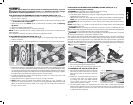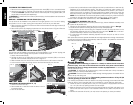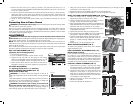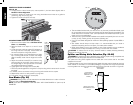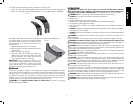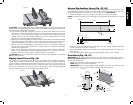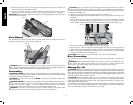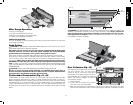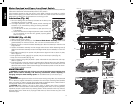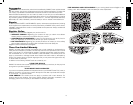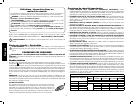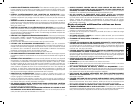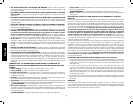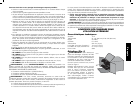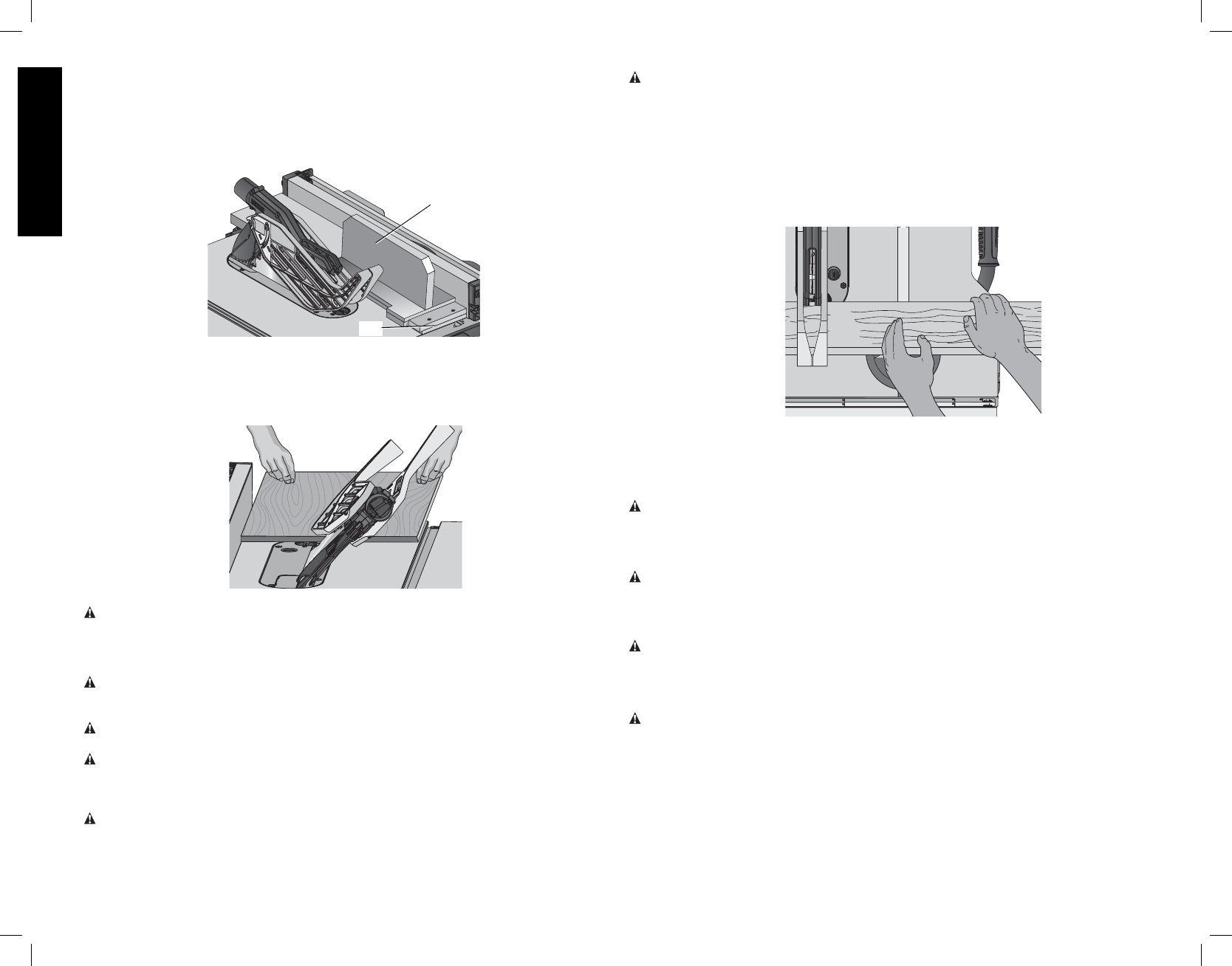
12
English
CAUTION: When using a block as a cut-off gauge, the block must be at least 3/4" (19mm)
thick and is very important that the rear end of the block be positioned so the workpiece is
clear of the block before it enters the blade to prevent contact with blade resulting in a thrown
workpiece and possibly injury.
1. Remove the rip fence and place the miter gauge in the desired slot.
2. Adjust the blade height so that the blade is about 1/8" (3.2mm) higher than the top of the
workpiece.
3. Hold the workpiece firmly against the miter gauge with the path of the blade in line with
the desired cut location. Keep the workpiece an inch or so in front of the blade. KEEP
BOTH HANDS AWAY FROM THE BLADE AND THE PATH OF THE BLADE (Fig. 39).
FIG. 39
4. Start the saw motor and allow the blade to come up to speed.
5. While using both hands to keep the workpiece against the face of the miter gauge, and
holding the workpiece flat against the table, slowly push the workpiece through the blade.
6. Never try to pull the workpiece with the blade turning. Turn the switch off, allow the blade
to stop, and carefully slide the workpiece out.
CAUTION: Never touch or hold onto the free or cut-off end of the workpiece.
Bevel Crosscutting
This operation is the same as crosscutting except that the bevel angle is set to an angle other
than 0°.
WARNING: Before connecting the table saw to the power source or operating the saw,
always inspect the blade guard assembly and riving knife for proper alignment and
clearance with saw blade. Check alignment after each change of bevel angle.
Mitering (Fig. 40)
WARNING: Miter angles greater than 45˚ may force the blade guard assembly into the saw
blade causing damage to the blade guard assembly and personal injury. Before starting the
motor, test the operation by feeding the workpiece into the blade guard assembly. If the blade
guard assembly contacts the blade, place the workpiece under the blade guard assembly, not
touching the blade, before starting the motor.
CAUTION: Certain workpiece shapes, such as molding may not lift the blade guard
assembly properly. Feed the workpiece slowly to start the cut. If the blade guard assembly
contacts the blade, place the workpiece under the blade guard assembly, not touching the
blade, before starting the motor.
This operation is the same as crosscutting except the miter gauge is locked at an angle other
than 0°. Hold the workpiece FIRMLY against the miter gauge (J) and feed the workpiece
slowly into the blade (to prevent the workpiece from moving).
2. Place the push block (UU, Fig. 37) behind the material and ensure the lip of the block is
flush to the narrow rip auxiliary fence (SS).
3. Once the push block is in place, continue feeding the material until the cut is complete
making sure the push block remains flush to the narrow rip auxiliary fence at all times.
IMPORTANT: The narrow rip auxiliary fence and the over hanging edge (W W, Fig. 36) should
both be the same thickness.
FIG. 37
UU
SS
Bevel Ripping
This operation is the same as ripping except the bevel angle is set to an angle other than zero
degrees. For proper hand position, Refer to figure 38.
FIG. 38
WARNING: Before connecting the table saw to the power source or operating the saw,
always inspect the blade guard assembly and riving knife for proper alignment and clearance
with saw blade. Check alignment after each change of bevel angle.
Crosscutting
WARNING: NEVER touch the “free end” of the workpiece or a “free piece” that is cut off,
while the power is ON and/or the saw blade is rotating. Piece may contact the blade resulting
in a thrown workpiece and possible injury.
WARNING: To reduce the risk of injury, NEVER use the fence as a guide or length stop
when crosscutting.
WARNING: NEVER use a length stop on the free end of the workpiece when crosscutting.
In short, the cut-off piece in any thru-sawing (cutting completely through the workpiece)
operation must never be confined — it must be allowed to move away from saw blade to
prevent contact with blade resulting in a thrown workpiece and possibly injury.
WARNING: Use caution when starting the cut to prevent binding of the blade guard
assembly against the workpiece resulting in damage to saw and possible injury.




